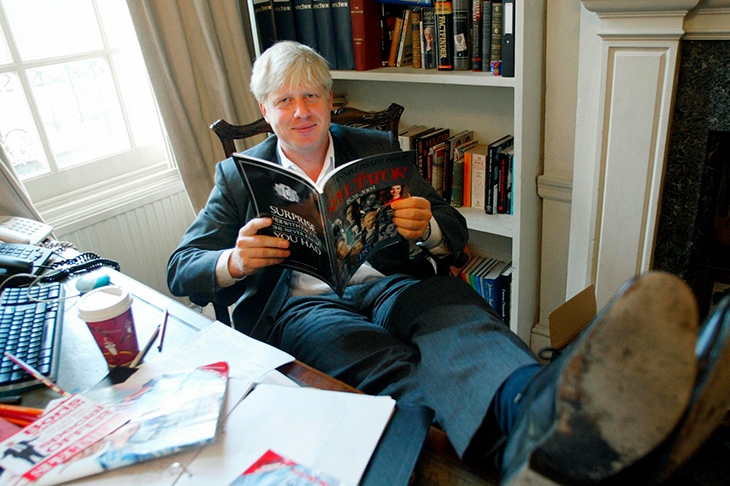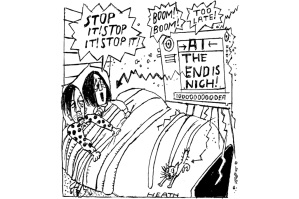Although I once edited this paper, and have written for it for almost 40 years, I did not know that it is the oldest magazine in the world. I learn this from 10,000 Not Out, David Butterfield’s short but scholarly new history of the paper from its foundation in 1828 to today. I wonder why it has survived. Here, more or less at random, are aspects emerging from the past 10,000 issues.
• The paper began with ‘News of the Week’ and continues — in much crisper form — with ‘Portrait of the Week’ to this day. From time to time, this has been dropped, but the paper has mysteriously suffered as a result. The same applies to the leading article. Neither feature is among the best-read of the paper, yet both somehow guarantee it: news and comment first; book reviews after. The formula worked at once, and works still.
• Jokes have always been allowed. In the high-Victorian years of the joint editorship of Meredith Townsend and Richard Hole Hutton (1861-97), the tone was often serious, but Butterfield unearths their parody of academic philological study in which the text of ‘Hey Diddle Diddle the cat and the fiddle’ is discovered as an ancient inscription with all the words run as one: ‘In old writing of this sort, where there is no distinction of words, the first point naturally is to ascertain if any particular combination of letters occurs more than once…here the letters THE occurring some seven times, gave the desired key to the whole. No one could doubt that they represented a common, and yet an important word.’ In 1967 the editor, Nigel Lawson, appointed Auberon Waugh as political columnist and put up a notice: ‘LIBEL. Mr Christopher Fildes and Mr Auberon Waugh have today joined the staff. As from today, The Spectator is no longer insured against libel.’
• The paper has never disdained stunts. J. St Loe Strachey (editor 1897-1924) offered a competition for the best ‘Model Wood Cottage’ that could be erected for £100 on his own estate. If, after a year, it could show it had withstood wind and rain, ‘I will then purchase it from [the winner] for the expended £100 upon it, plus £10 for a year’s loss of interest on capital’. If not, he would give the man who built it the land upon which it stood, plus access. The winner was the young Clough Williams-Ellis who, a year later, married Strachey’s daughter Amabel. Even more remarkable was The Spectator’s contribution to readiness for the Great War, which it presciently saw — as early as 1906 — was coming. Strachey proposed to train up ‘a hundred teenage lads’ to battle-readiness within six months. The Spectator Experimental Company was formed, funded by readers’ donations. It worked. King Edward VII inspected the recruits, and the following year, Haldane, the secretary of state for war, used The Spectator’s model to create the Territorial Army. With recruitment so weak today, perhaps the Old Queen Street Irregulars should offer a version of the original.
• The Spectator gave birth to the following familiar phrases — the establishment (Henry Fairlie), the nanny state (Iain Macleod), young fogey (Alan Watkins), virtue-signaling (James Bartholomew).
• It is, as a general rule, a bad idea for MPs to be editors of the paper, because their career ambitions tend to clash with The Spectator’s journalistic independence. It was outrageous that Boris Johnson was made to ‘apologize to Liverpool’ by his party’s leader, about a leading article published in The Spectator under his editorship: the paper is not under the control of any party. Yet the fact is that the three editors who were also sitting MPs — Ian Gilmour (also proprietor), Iain Macleod and Johnson — were all very good at the job, as was Nigel Lawson, who became an MP later. General rules are often successfully broken in this paper’s history.
• Mistakes. In an interview with Il Duce in 1926, Francis Yeats-Brown wrote that Mussolini ‘would not willingly harm a mouse’. From 1859-61, the paper went through a weird period in which it was, in effect, secretly owned by two Americans, one of whom, Benjamin Moran, was the United States ambassador in London. They turned it into a propaganda sheet for President James Buchanan. There were also long periods when the paper campaigned for teetotalism.
• The paper was sold three times for the same sum (and therefore for greatly decreasing real value) — £75,000 — in 1951, 1967 and 1975. Today, it is thought to be worth more than £20 million ($24.7 million).
• Obviously, famous people have often written for The Spectator, but that is not so important. What is striking is to find the writers who later became famous. The paper’s roll-call of these of these includes John Buchan, Graham Greene, Bernard Levin and Hilary Mantel. Karl Marx had a letter published in 1850.
• In February 2006, The Spectator online was the only British publication brave enough to republish the Danish cartoon of the prophet Muhammad with his turban rendered as a bomb. Its editor at that time was Dominic Cummings, now famous for other reasons. If one had to single out a common thread in the magazine which has made it sometimes Tory, sometimes Liberal, sometimes politically homeless (and never socialist), it has been a love of freedom. This love is expressed not only in political and cultural views but in its attitude to the readers. They were thus defined, in 2005, by the then editor, whose style discloses his identity: ‘He or she could be anyone who likes to be provoked in their journalism and likes good writing…I could not say that the Spectator reader has the mouth of Marilyn Monroe, the mind of Einstein, and the legs of, erm, Kermit the Frog. Just people who like the feel of something civilized and different.’ This was true under its individualistic first editor, a brave Scot called Robert Rintoul, and it is true under the brave, individualistic Scot who edits it today.
This article was originally published in
The Spectator’s 10,000th UK magazine. Subscribe to the US edition here.


















